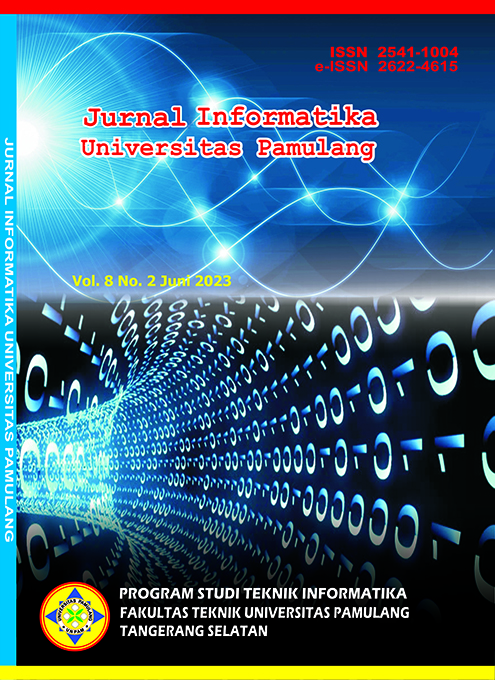Analisis Sentimen Tanggapan Masyarakat terhadap Calon Presiden Ridwan Kamil 2024 Menggunakan Metode K-Nearest Neighbor
DOI:
https://doi.org/10.32493/informatika.v8i2.30054Keywords:
Sentiment analysis, President, Ridwan Kamil, K-Nearest Neighbor, TwitterAbstract
Banyaknya berita yang beredar dalam sosial media mengenai Tanggapan Masyarakat Terhadap Calon Presiden Ridwan Kamil 2024 menggugah rasa penasaran penulis untuk memastikan seperti apakah tanggapan masyarakat mengenai calon presiden ridwan kamil, apakah menuai kesan positif atau negatif. Dengan demikian, penulis melakukan analisis sentimen pengguna twitter terhadap Tanggapan Masyarakat Terhadap Calon Presiden Ridwan Kamil 2024 yang dapat digunakan sebagai bahan evaluasi dalam menentukan kebijakan. Penulis menggunakan algoritma K-Nearest Neighbor untuk menentukan sentimen pengguna twitter dengan bantuan phyton yang populer di kalangan Data Scientist. Metode tersebut diterapkan ke 2261 data tweet dengan kata kunci “calon presiden ridwan kamil†yang dikumpulkan pada 20 Desember 2022– 30 Desember 2022, yang mana hasil data bersih dari data tersebut berjumlah 1504 data tweet. Hasil training model membuktikan bahwa skor akurasi 88,70%, recall 96,92% , dan presisi 90,65% dengan nilai k=3.
References
Agustian S. & Ramadhani S., “Jurnal Computer Science and Information Technology ( CoSciTech ) menggunakan algoritma lexrank,†vol. 3, no. 3, pp. 371–381, 2022.
Andriana H., Hilab S. S. “Penerapan Metode K-Nearest Neighbor pada Sentimen Analisis Pengguna Twitter terhadap KTT G20 di Indonesia,†JURIKOM (Jurnal …, vol. 10, no. 1, pp. 60–67, 2023, doi: 10.30865/jurikom.v10i1.5427.
Asro’I, A. & Februariyanti, H. “Analisis Sentimen Pengguna Twitter Terhadap Perpanjangan Ppkm Menggunakan Metode K-Nearest Neighbor,†J. Khatulistiwa Inform., vol. 10, no. 1, pp. 17–24, 2022, doi: 10.31294/jki.v10i1.12624
Dharmawan L. R., Arwani I., & Ratnawati D. E. “Analisis Sentimen pada Sosial Media Twitter Terhadap Layanan Sistem Informasi Akademik Mahasiswa Universitas Brawijaya dengan Metode K- Nearest Neighbor,†J. Pengemb. Teknol. Inf. dan Ilmu Komput., vol. 4, no. 3, pp. 959–965, 2020, [Online]. Available: http://j-ptiik.ub.ac.id/index.php/jptiik/article/view/7099
Cahyani N., Informasi J., S., Nasional U., & Neighbors K. “Pandemi Dengan Metode Support Vector Machine Dan K-Nearest Neighbors,†vol. 7, no. 2, 2022.
Mahawardana P., Imawati I., & Dika I. “Analisis Sentimen Berlandaskan Opini dari Media Sosial Twitter terhadap ‘Figure Pemimpin’ Menggunakan Python,†J. Manaj. dan Teknol. Inf., vol. 12, no. 2, pp. 50–56, 2022.
Sari R., “Analisis Sentimen Pada Review Objek Wisata Dunia Fantasi Menggunakan Algoritma K-Nearest Neighbor (K-Nn),†EVOLUSI J. Sains dan Manaj., vol. 8, no. 1, pp. 10–17, 2020, doi: 10.31294/evolusi.v8i1.7371.
Rahayu S., Bororing J., & Hadiyat R., “Implementasi Metode K-Nearest. Neighbor (K-NN) untuk Analisis Sentimen Kepuasan Pengguna Aplikasi Teknologi Finansial FLIP,†Edumatic J. Pendidik. Inform., vol. 6, no. 1, pp. 98–106, 2022, doi: 10.29408/edumatic.v6i1.5433
Rezeki S., “Pemakaian sosial media twitter dalam komunikasi organisasi (studi kasus pemerintah provinsi dki jakarta dalam penanganan covid-19),†J. Islam. Law Stud., vol. 04, no. 02, pp. 63–78, 2020.
Downloads
Published
Issue
Section
License
Authors who publish with this journal agree to the following terms:
- Authors retain copyright and grant the journal right of first publication with the work simultaneously licensed under a Creative Commons Attribution-NonCommercial 4.0 International (CC BY-NC 4.0) that allows others to share the work with an acknowledgement of the work's authorship and initial publication in this journal.
- Authors are able to enter into separate, additional contractual arrangements for the non-exclusive distribution of the journal's published version of the work (e.g., post it to an institutional repository or publish it in a book), with an acknowledgement of its initial publication in this journal.
- Authors are permitted and encouraged to post their work online (e.g., in institutional repositories or on their website) prior to and during the submission process, as it can lead to productive exchanges, as well as earlier and greater citation of published work (See The Effect of Open Access).
Jurnal Informatika Universitas Pamulang have CC-BY-NC or an equivalent license as the optimal license for the publication, distribution, use, and reuse of scholarly work.
In developing strategy and setting priorities, Jurnal Informatika Universitas Pamulang recognize that free access is better than priced access, libre access is better than free access, and libre under CC-BY-NC or the equivalent is better than libre under more restrictive open licenses. We should achieve what we can when we can. We should not delay achieving free in order to achieve libre, and we should not stop with free when we can achieve libre.
Jurnal Informatika Universitas Pamulang is licensed under a Creative Commons Attribution-NonCommercial 4.0 International (CC BY-NC 4.0)
YOU ARE FREE TO:
- Share : copy and redistribute the material in any medium or format
- Adapt : remix, transform, and build upon the material for any purpose, even commercially.
- The licensor cannot revoke these freedoms as long as you follow the license terms





